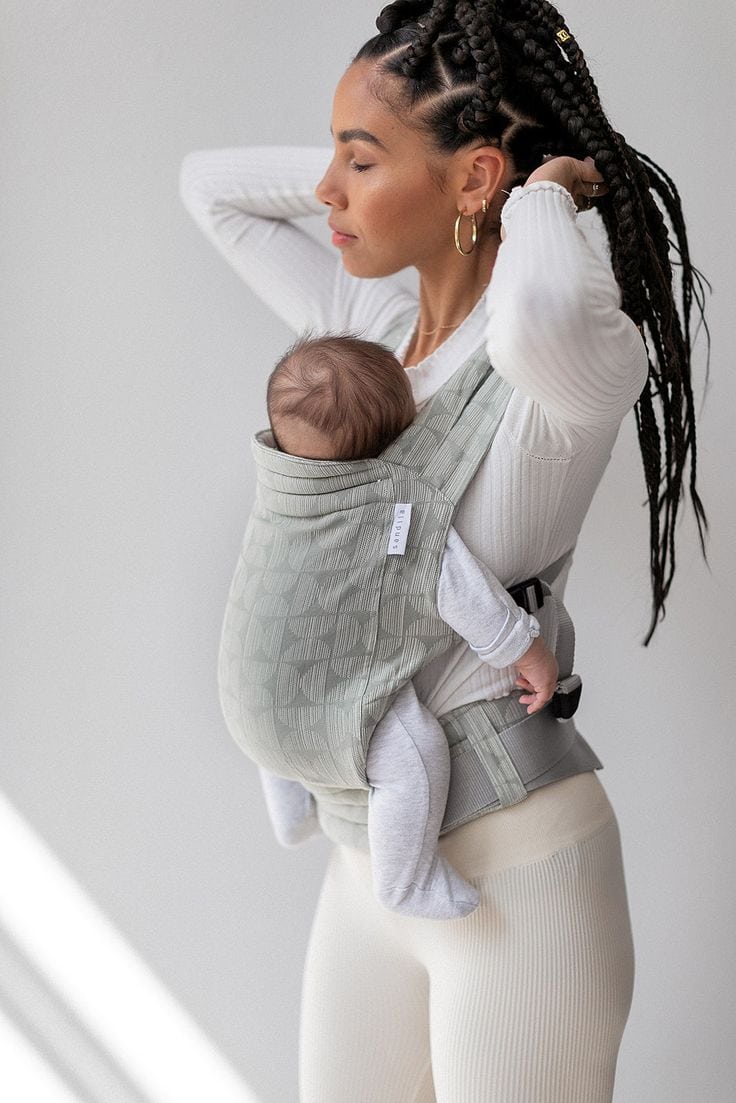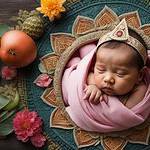What are stroller alternatives?
Stroller alternatives like baby carriers, wraps, slings and back carriers are suitable from birth, offering close bonding and convenience. Ensure proper support for newborns’ delicate necks.
Our blog will discuss 19 stroller alternatives; from baby alternatives like a baby hip seat to toddler alternatives like Piggyback riders and Multiple kids‘ alternatives e.g. buggy boards.
Children remind us of all the precious things in life, like uninterrupted sleep, extra spending, money, and sanity.
Let’s dive deep into 19 best stroller alternatives for your little one to keep you calm and sane!
Introduction : Stroller Alternatives
The joys of traveling with a toddler…
A time filled with laughter, discovery, and the occasional “I don’t want to sit in the stroller!” tantrum in the middle of a bustling street.
Having a two-year-old is like owning a blender that you don’t have the top for! Chaos at the very least!

But fear not, intrepid parent-adventurers, for we have rounded up the ultimate list of stroller alternatives that might just make your little one forget about the traditional four-wheeled contraption.
Whether you’re juggling luggage at the airport or trying to keep up with a toddler who has just discovered the speed of their own two feet, these stroller alternatives are here to save the day (and perhaps your back, too!).
From stylish baby slings to toddler ride-ons that might just give your favorite suitcase a run for its money, these 19 options are designed to make your travels less about the fuss and more about the fun. Remember to find many more handy Stroller Guides on our website.
Why Would You Need An Stroller
Before becoming a parent, I didn’t know I could ruin someone’s life by asking them to put pants on…
Tantrums and optional clothing apparently, aside, do you really need an alternative to a stroller?
While strollers are a popular choice for transporting toddlers, they aren’t always the most practical option.
- Stroller alternatives for travel can prove to be more adaptable and convenient, particularly in situations involving rough terrains, stairs, and narrow pathways where maneuvering a stroller can be challenging.
- These stroller alternatives, which range from carriers to harnesses, not only facilitate easier travel and public transportation use but also promote closer bonding between the parent and child, fostering a sense of security and comfort for the toddler.

- Moreover, stroller alternatives can encourage toddlers to walk and explore their surroundings, fostering independence and active engagement with the environment.
- They are often more space-efficient, easy to transport, and adaptable to the caregiver’s body, offering ergonomic benefits.
- In crowded places or during adventurous activities, these alternatives can provide better control and safety.
Ultimately, having a stroller alternative at hand can make your travels smoother and more enjoyable, catering to the comfort and happiness of both the toddler and the parent.
Stroller Alternatives For Babies
Baby Carriers
Baby carriers are a great way to hold your baby. They can be used from birth through toddlerhood and in different ways, depending on the carrier you choose.
Most carriers have a variety of positions that will allow you to carry your child on your front, back, or hip.
There are many different types of baby carriers available: slings, wraps, and soft structured carriers (SSCs).
Watch the video below or read on to discover more about baby carriers.
Benefits of Baby Carriers:
- Hands-Free Convenience: Baby carriers are a game-changer, offering you the freedom to use your hands without worrying about your toddler’s safety. Now, sipping that latte or browsing through racks of clothes becomes a tad easier!
- Close Bonding: Nothing beats the feeling of having your toddler close to you, feeling their heartbeat against yours. It’s a bonding experience that’s almost poetic, fostering a strong connection between you and your munchkin.
- Physical Benefits: Let’s face it, carrying a toddler is practically a workout. Baby carriers offer the ergonomic advantage, helping you maintain a good posture while you carry your little one, saving you from potential back aches.
- Travel-Friendly: Compact and easy to pack, these carriers are a traveler’s dream. They can be quickly folded and tucked away, making them a convenient companion for your explorations with your tiny globetrotter.
In the grand scheme of parenting adventures, baby carriers stand as a beacon of convenience and style, making those trips with your toddler less about the struggle and more about the joyous moments you share together.
So, gear up and step out in style with a baby carrier that promises not just comfort for your toddler but also a dash of flair for you! Find another excellent blog here: Best baby carrier on a budget
Soft Structured Carriers:
Soft structured baby carriers are designed to combine the comfort and closeness of a wrap or sling with the convenience and support of a structured carrier.
These carriers usually feature padded shoulder straps and a wide waistband to distribute the baby’s weight evenly across the wearer’s shoulders and hips, providing comfortable and ergonomic support for both the baby and the parent. They often include adjustable settings and offer various carrying positions.

Material:
- Cotton: Generally used for its breathability and durability.
- Polyester: Often used in the lining for its durability and resistance to shrinkage.
Weight Capacity:
- Generally suitable for babies and toddlers weighing between 7 to 45 pounds. Always adhere to the manufacturer’s recommended weight limits.
Adjustability:
- Shoulder Straps: Often adjustable to accommodate different body types and sizes.
- Waistband: Typically includes an adjustable waistband to ensure a snug and comfortable fit.
Carrying Positions:
- Front Inward-Facing: Suitable for newborns and young infants, promoting closeness and bonding.
- Front Outward-Facing: Suitable for babies who have developed neck control, usually around 4-6 months.
- Hip Carry: Suitable for babies who have developed some sitting ability, usually from 6 months onwards.
- Back Carry: Suitable for toddlers or older infants, generally starting around 6-12 months, depending on the carrier and the child’s development.
Head and Neck Support:
- Often includes adjustable head and neck support to provide stability for newborns and sleeping babies.
Comfort:
- Padded Shoulder Straps: To provide comfort and reduce strain on the wearer’s shoulders.
- Wide Waistband: To evenly distribute the baby’s weight and reduce pressure on the wearer’s lower back.
Safety Features:
- Safety Buckles: To prevent accidental openings.
- Reflective Strips: Some carriers feature reflective strips for visibility in low light conditions.
Additional Features:
- Storage Pockets: To carry essentials like diapers, wipes, and small personal items.
- Hood: To protect the baby from the sun or provide privacy during breastfeeding.
- Teething Pads: Some carriers come with attachable teething pads for babies to gnaw on.
Designs and Patterns:
- Available in various designs and patterns to suit different tastes and preferences.
Wraps:
Baby wraps are a popular type of baby carrier that consists of a long piece of fabric, which is wrapped around the parent’s body to create a snug and secure space for the baby.
They are known for promoting closeness and facilitating bonding between the parent and the baby. They are versatile, allowing various carrying positions and can be adjusted to suit different body types.
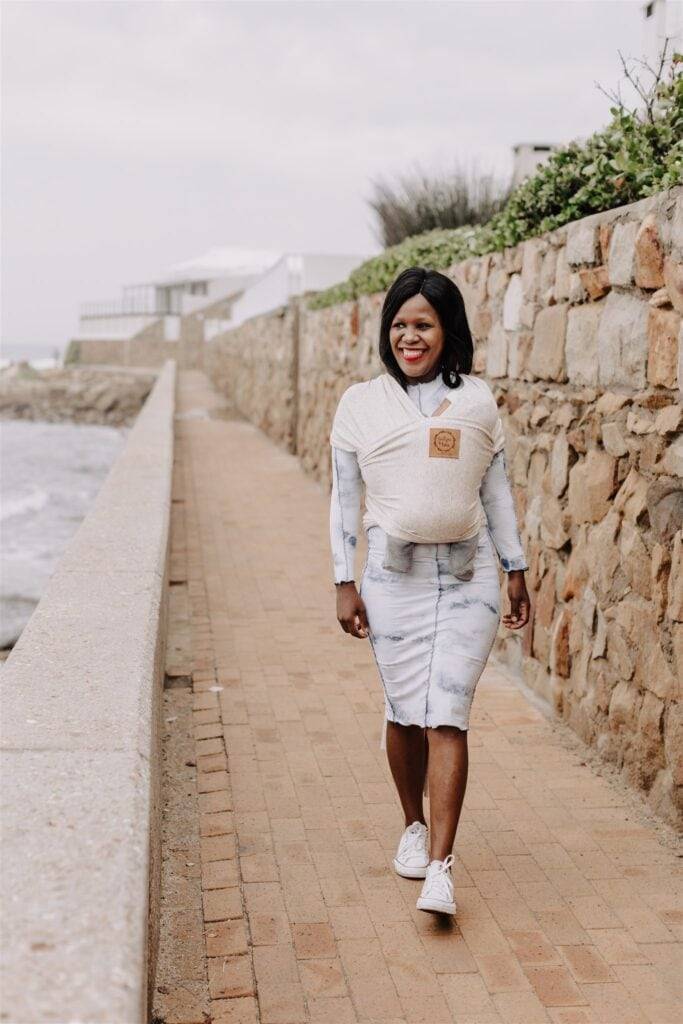
Material:
- Cotton: Breathable and soft, suitable for all seasons.
- Linen: Light and airy, ideal for hot weather.
- Bamboo: Offers excellent moisture-wicking properties and is exceptionally soft.
- Spandex or Elastane (Blend): Sometimes blended with other materials to provide a little stretch for comfort and ease of use.
Dimensions:
- Length: Generally varies from 14.7 feet to 18 feet to accommodate different body sizes and wrapping styles.
- Width: Typically between 20 to 30 inches to provide ample support to the baby.
Weight Capacity:
- Suitable for newborns and infants, generally supporting weight ranges from 8 to 35 pounds. However, this can vary between brands and models.
Carrying Positions:
- Front Carry: Ideal for newborns and smaller infants, promoting skin-to-skin contact and bonding.
- Hip Carry: Suitable for infants who have developed neck control, usually around 4-6 months.
- Back Carry: Suitable for older infants and toddlers, generally starting from 6-8 months, but this largely depends on the individual baby’s development and the comfort level of the caregiver.
Design:
- Available in a plethora of designs, patterns, and colors to suit different personal styles.
- May feature slight variations in the weave to offer differing levels of stretch and support.
Safety:
- Always ensure that the wrap is tied securely to prevent the baby from slipping or falling.
- The baby’s face should always be visible, and the chin should not be pressed against the chest to ensure open airways.
Additional Tips:
- Learning to use a wrap can have a slight learning curve. Many parents find it beneficial to watch instructional videos or attend workshops to master different wrapping techniques.
- Ensuring the baby is in an ergonomic position, with the hips in an “M” shape and the back well-supported, is vital for the baby’s comfort and development.
Baby Slings – Stroller Alternatives
Ring Sling:
A ring sling is a type of baby carrier that consists of a long piece of fabric, typically between 1.7 to 2.2 meters in length, with two rings secured at one end.
The other end of the fabric is threaded through the rings, creating an adjustable pouch where a baby can sit or lie down.
This carrier is designed to be worn over one shoulder, distributing the baby’s weight across the wearer’s shoulder and hip.
They are popular for their simplicity, ease of use, and the closeness they facilitate between the baby and the wearer.
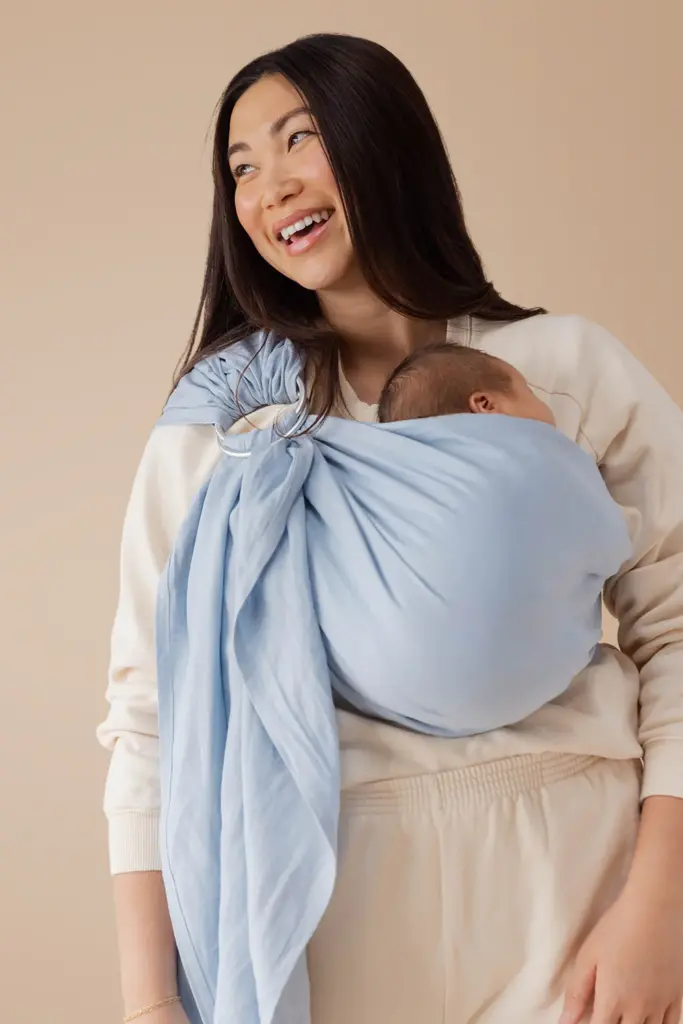
Material:
- Cotton: Soft, breathable, and durable, making it suitable for prolonged use.
- Linen: Lightweight and breathable, ideal for hot weather.
- Bamboo: Known for its softness and moisture-wicking properties.
Ring Material:
- Aluminum: Lightweight yet sturdy, commonly used in high-quality slings.
- Nylon: Generally durable and may be found in budget-friendly options.
Weight Capacity:
- Most ring slings can safely hold babies and toddlers weighing between 8 to 35 pounds. Always refer to the manufacturer’s guidelines on weight capacity to ensure safe use.
Width:
- A width ranging from 24 to 30 inches is common to provide ample support for the baby.
Shoulder Design:
- Padded: Offers additional comfort for the wearer, especially during extended use.
- Gathered: The fabric is gathered at the shoulders, allowing for better weight distribution.
Adjustability:
- The sling should offer easy adjustability to accommodate your growing baby and different carrying positions.
Additional Features:
- Pocket: Some slings come with built-in pockets for storing small items like keys or a cellphone.
- Tail: The fabric tail that hangs from the rings can sometimes be used as a nursing cover or sunshade.
- Colors and Patterns: Available in a variety of colors and patterns to suit personal preferences and styles.
Backpack Carriers – Stroller Alternatives
Framed Backpack Carriers:
Framed backpack baby carriers are designed to carry children, usually toddlers and older infants, on the back of the caregiver.
These carriers are structured with a rigid frame that offers stability and support, making them suitable for long walks, hiking, and other outdoor activities.
They are characterized by their robust build, offering various features for both the child and the caregiver’s comfort and safety.

Material:
- Polyester: Widely used due to its durability and resistance to weather elements.
- Nylon: Another popular choice, known for its durability and lightweight properties.
Frame Material:
- Aluminum: Commonly used to construct the frame due to its strength and lightweight properties.
Weight Capacity:
- Generally designed to carry children who can sit up unassisted, usually from 16 to 50 pounds, although this can vary between products.
Adjustable Features:
- Shoulder Straps: Padded and adjustable to suit different body sizes.
- Waist Belt: Often padded, to distribute weight evenly and reduce pressure on the back.
Carrying Positions:
- Back Carry: Primarily designed for back carrying, offering a higher sitting position for the child to have a broader view of their surroundings.
Safety Features:
- Secure Harness: To safely secure the child in the carrier.
- Stability Stand: A stand to keep the carrier upright when placing the child in or taking them out.
Comfort Features:
- Padded Seat: To provide comfort to the child during long journeys.
- Sunshade or Canopy: To protect the child from sun and weather elements.
- Stirrups: For older children to rest their legs.
Additional Features:
- Storage Compartments: Often come with multiple pockets or compartments to store necessary items such as diapers, food, and personal belongings.
- Hydration Pouch: Some carriers offer a space to hold a hydration bladder or water bottles.
Designs:
- Available in a variety of designs, catering to different aesthetic preferences and functionalities.
Wearable Carriers – Stroller Alternatives
Mei Tai Carrier:
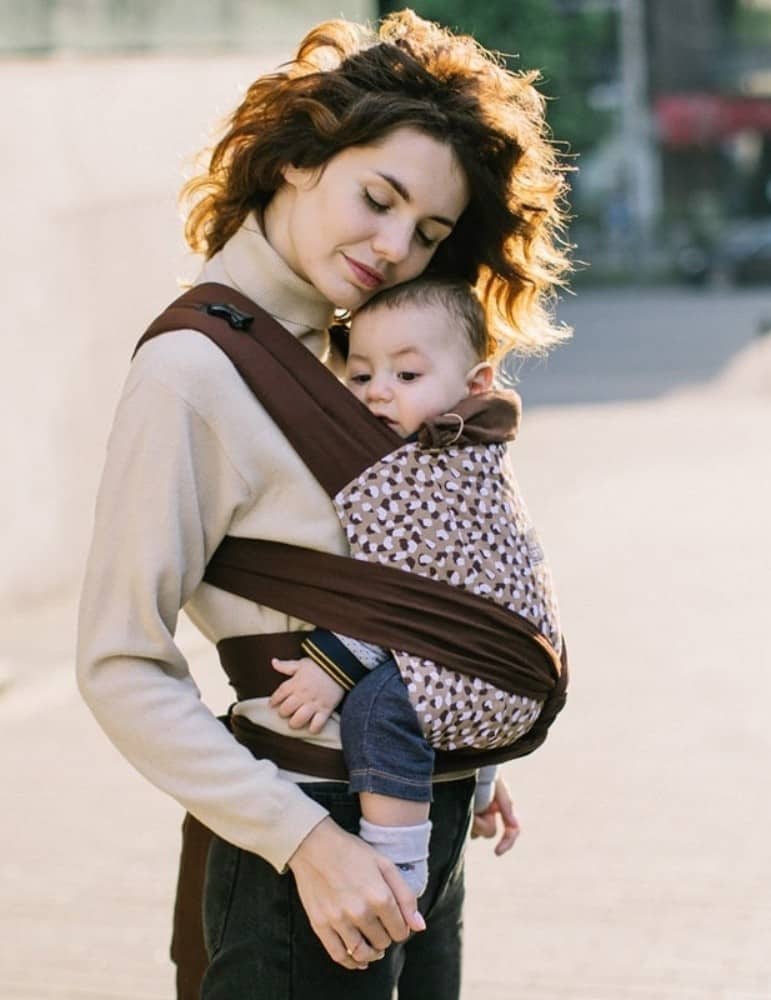
The Mei Tai is a traditional Asian baby carrier that embodies simplicity and versatility. It consists of a rectangular body panel with four straps: two shorter ones at the waist and two longer ones for the shoulders.
This carrier provides a snug and comfortable environment for the baby while evenly distributing the baby’s weight across the wearer’s shoulders and hips.
It can be utilized for multiple carrying positions and is adaptable to suit different body types, offering a more custom fit than some other types of carriers.
Material:
- Cotton: Predominantly used for its comfort and breathability.
- Linen: Sometimes used for its lightweight and breathable properties, ideal for warmer climates.
- Canvas: Used for durability and strong support, especially in the body panel.
Dimensions:
Weight Capacity:
- Generally, supports a weight range of 8 to 35 pounds, making it suitable for newborns to toddlers. Always adhere to the manufacturer’s specific weight guidelines.
- Body Panel: Varies between products, but generally measures around 14-16 inches in width and 20-24 inches in height to provide adequate support to the baby.
- Straps: The waist straps usually range from 60-75 inches, and the shoulder straps range from 65-80 inches, to cater to different body sizes and wrapping styles.
Carrying Positions:
- Front Carry: Allows the baby to be carried at the front, facing inward, suitable for infants and younger babies.
- Hip Carry: Allows the baby to be carried on the hip, which is generally preferred for older infants.
- Back Carry: Suitable for older babies and toddlers, offering convenience during long walks or chores.
Adjustability:
- Shoulder Straps: Can be tied in various ways to distribute weight evenly and provide customized comfort.
- Waist Straps: Can be adjusted to provide a snug fit for the caregiver.
Design:
- Available in various patterns, colors, and sometimes with embroidered accents or embellishments.
- Some versions offer additional features like a headrest or hood for the baby, and padded shoulder straps for extra comfort.
Additional Tips:
- For newborns and smaller infants, ensure that they are positioned in an ergonomically correct “M” position, with their knees at or above hip level to promote healthy hip development.
- As with any baby carrier, it’s vital to ensure that the baby’s airways remain clear at all times and that they are monitored frequently while in the carrier.
Baby Hip Seat Carrier – Stroller Alternatives
Hip Seat Carrier:
Hip seat baby carriers are designed to alleviate the strain on your back and shoulders when carrying your baby for extended periods.
It incorporates a wide, padded waistband with an attached seat for the baby to sit on, which helps to distribute the baby’s weight more evenly and maintain a more ergonomic position.
These carriers can come with additional attachments and features like a back panel with shoulder straps to convert it into a full carrier.

Material:
- Polyester: Commonly used due to its durability and easy maintenance.
- Breathable Fabrics: Many models incorporate breathable fabrics to prevent overheating in the baby and the parent.
Hip Seat:
- Seat Material: Often made with EPP foam or similar materials that offer firm yet comfortable support.
- Seat Angle: Designed at a specific angle to promote an ergonomic “M” seated position for healthy hip development.
- Width: Generally, the seat is wide enough to provide stable and comfortable support, usually ranging between 11-15 inches.
Weight Capacity:
- Generally, supports a weight range of 15 to 45 pounds, but always refer to the manufacturer’s guidelines.
Adjustable Features:
- Waist Belt: Adjustable to fit a wide range of waist sizes, often ranging from 25 to 50 inches.
- Shoulder Straps (if included): Adjustable to suit various body types and sizes, and often padded for added comfort.
Carrying Positions:
- Hip Carry: The primary position, which facilitates easy hip carrying, suitable for babies who can sit unassisted.
- Front and Back Carry: Many models can be converted to a full carrier, allowing front inward-facing and back carrying positions, suitable for older infants and toddlers.
Safety Features:
- Safety Straps and Buckles: To securely hold the baby in place.
- Non-slip Seat: Many hip seats feature a non-slip surface to prevent the baby from sliding.
Additional Features:
- Storage Pockets: Convenient pockets for storing small items like keys, phones, or baby essentials.
- Removable Panel: Some carriers feature a removable back panel that can be detached when not needed, converting it into a hip seat only.
- Hood: Models with a back panel often include a hood to protect the baby from sun or rain, or to provide privacy during breastfeeding.
Baby Hiking Backpack – Stroller Alternatives
Hiking Backpack Carrier:
Hiking backpack carriers are great stroller alternatives. They are specially designed to enable parents to carry their children safely while hiking or engaging in other outdoor activities.
They are characterized by a sturdy frame that supports the child’s weight efficiently, coupled with various features aimed at providing comfort and safety for both the child and the parent.
These carriers usually offer a higher sitting position for the child, offering them a broad view of their surroundings, and are equipped with amenities for storage, sun protection, and more.
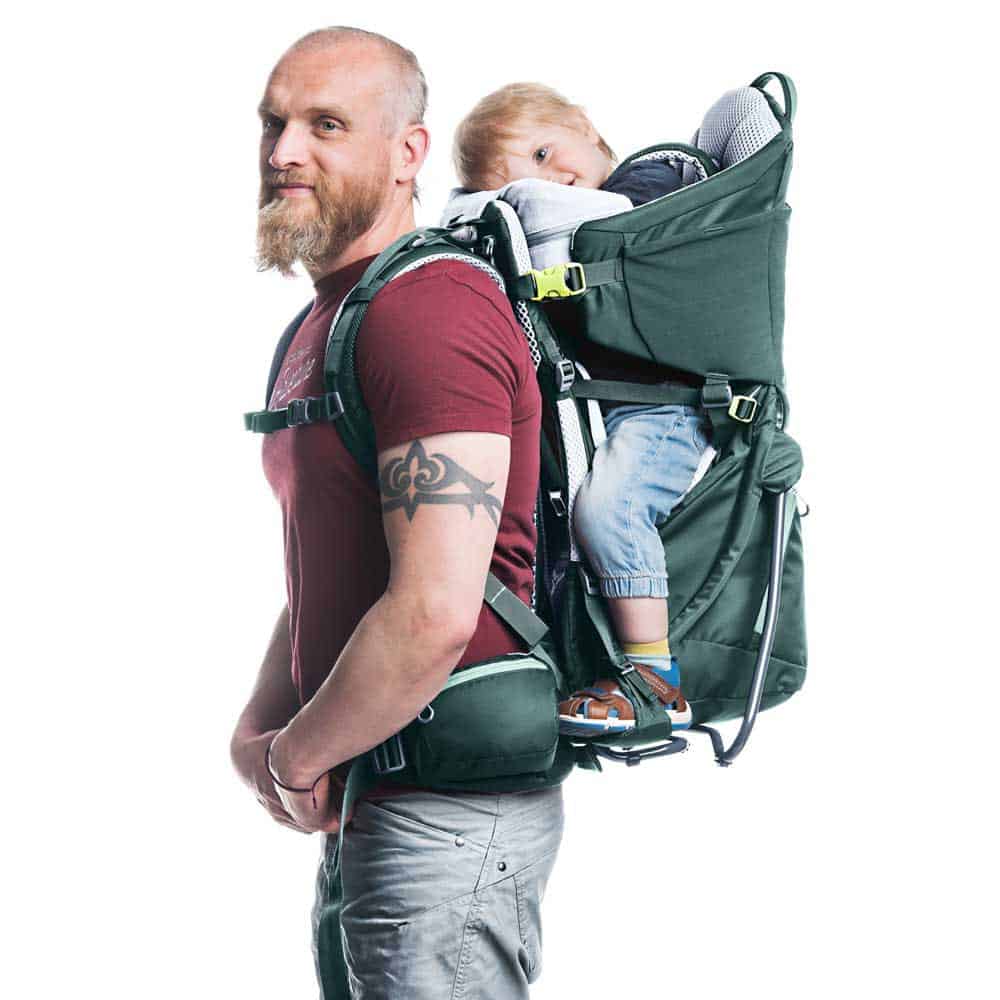
Material:
- Polyester and Nylon: These are the primary materials used due to their durability, water resistance, and lightweight properties.
- Mesh Fabric: Integrated for better airflow and to prevent sweating, especially in the back and seat areas.
Frame:
- Aluminum: Generally utilized for the frame structure, offering a lightweight yet sturdy support system.
Weight Capacity:
- Typically capable of supporting a child weighing between 16 to 50 pounds, but always adhere to the manufacturer’s specific weight guidelines.
Adjustable Features:
- Shoulder Straps and Hip Belt: These are adjustable and usually padded to suit various body sizes and ensure comfort during long hikes.
- Child’s Seat: Adjustable to fit the child’s size, with a harness to secure them safely.
Carrying Positions:
- Back Carry: Designed exclusively for back carrying, providing the child with a clear and elevated view of the surroundings.
Safety Features:
- Stable Base: Features a stable base or kickstand to securely set the carrier down when needed.
- Child Harness: Includes a secure harness system to keep the child safely strapped in.
Comfort Features:
- Sunshade or Canopy: Integrated to protect the child from sun exposure or rain.
- Padded Seating Area: Designed to keep the child comfortable during the journey.
Additional Features:
- Storage Compartments: Equipped with pockets or compartments for storing necessities like water bottles, diapers, and snacks.
- Hydration Reservoir Sleeve: Some models come with a hydration reservoir sleeve to hold water bladders for easy hydration during the hike.
Designs:
- Various designs are available, each offering different features and aesthetics to cater to diverse preferences and needs.
Hand-held Carriers – Stroller Alternatives
Toddler Handle:
A toddler handle is a simple device used to help toddlers learn to walk and balance without the parent having to bend over. It also assists in keeping the child safe and close during outings.
It generally comes in the form of a handle or strap that can be attached to the toddler’s back or wrists, giving the parent a comfortable grip while maintaining the child’s upright position.
They are often used when transitioning from a stroller to walking, especially in crowded or unsafe areas.
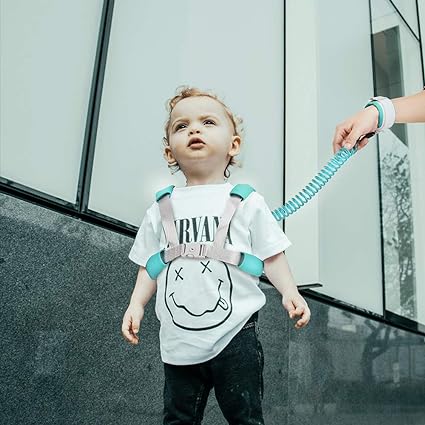
Material:
- Fabric Straps: Often made from durable and breathable fabrics like nylon or cotton, which are gentle on the toddler’s skin.
- Handles: Usually crafted from materials such as plastic or cushioned materials to provide a comfortable grip for the parent.
Dimensions:
- Strap Length: Generally adjustable, ranging from around 30 to 50 inches to accommodate various heights and preferences.
- Handle Width: Typically around 4 to 6 inches, designed to provide a firm and comfortable grip.
Adjustable Features:
- Strap Adjustments: Most models allow for the adjustment of strap length to fit different toddler sizes and parental heights.
- Wrist Straps: Some designs come with wrist straps that can be adjusted to fit snugly around the toddler’s wrist.
Safety Features:
- Secure Fastenings: Equipped with secure buckles and fastenings to ensure the toddler cannot easily remove the handle.
- Reflective Materials: Some models incorporate reflective materials to enhance visibility in low-light conditions.
Comfort Features:
- Padded Handles: Many toddler handles feature padded handles for a comfortable grip during extended use.
- Breathable Fabric: Straps made from breathable fabric prevent irritation and discomfort for the toddler.
Additional Features:
- Detachable Handle: Certain models feature a detachable handle for versatile usage.
- Storage Pockets: Some handles come with built-in pockets for storing small items like keys or snacks.
Stroller Alternatives For Toddlers
Harnesses and Leashes
Toddler Safety Harness:
A toddler safety harness is a protective accessory designed to keep toddlers secure and close to the caregiver during outings, especially in crowded or potentially dangerous areas.
These harnesses usually resemble a small backpack or a set of straps that are worn by the toddler, with a leash that the caregiver holds onto.
They provide a safe way for toddlers to explore their surroundings while minimizing the risk of them wandering too far away or getting lost.
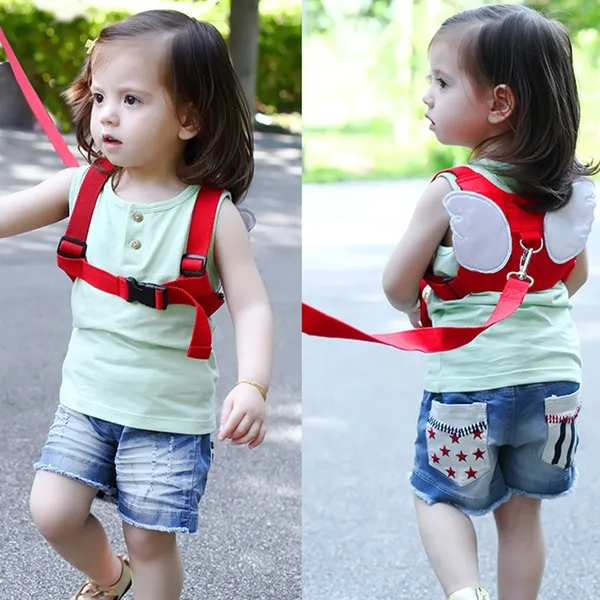
Material:
- Nylon and Polyester: Durable and lightweight materials often used for the harness and leash components due to their strength and longevity.
- Breathable Fabric: Integrated to promote comfort and prevent overheating, especially for the harness part that is in direct contact with the toddler.
Harness Design:
- Backpack Style: Resembles a small backpack that the toddler wears, with a leash attached to the back.
- Vest Style: A harness that resembles a vest, providing more coverage and usually including shoulder straps and a chest buckle.
Dimensions:
- Leash Length: Typically ranges from 3 to 5 feet to allow some freedom of movement while maintaining safety.
- Harness Size: Generally adjustable to fit a wide range of toddler sizes.
Adjustable Features:
- Shoulder Straps: Designed to be adjustable to fit snugly and comfortably on the toddler.
- Waist Belt: Often included to provide additional security and prevent the toddler from slipping out of the harness.
Safety Features:
- Secure Buckles: Designed to be secure yet easy for the adult to open, preventing the toddler from removing the harness themselves.
- Reflective Strips: Incorporated in some models to enhance visibility in low light conditions.
Comfort Features:
- Padded Straps: To prevent chafing and enhance comfort, especially during extended use.
- Soft Fabrics: Materials that are gentle on the toddler’s skin to avoid irritation.
Additional Features:
- Detachable Leash: Allows the harness to be used as a standalone backpack or vest when the leash is not needed.
- Storage Compartments: Integrated into the backpack style harnesses, offering a space for toddlers to carry small toys or snacks.
Portable Pushchair – Stroller Alternatives
Compact Pushchairs:
Compact pushchairs, also known as compact strollers, are lightweight and foldable strollers designed for parents and caregivers seeking mobility and convenience.
These pushchairs are ideal for urban environments, frequent travel, and situations where storage space is limited.
They combine the functionality of a full-size stroller with the convenience of a more compact, portable design.
They offer a variety of features aimed at ensuring the comfort and safety of the child while providing ease of use for the adult.
Read our Blog: GB Pockit Plus Ultra Compact Lightweight Strollers: for On-the-Go Parents
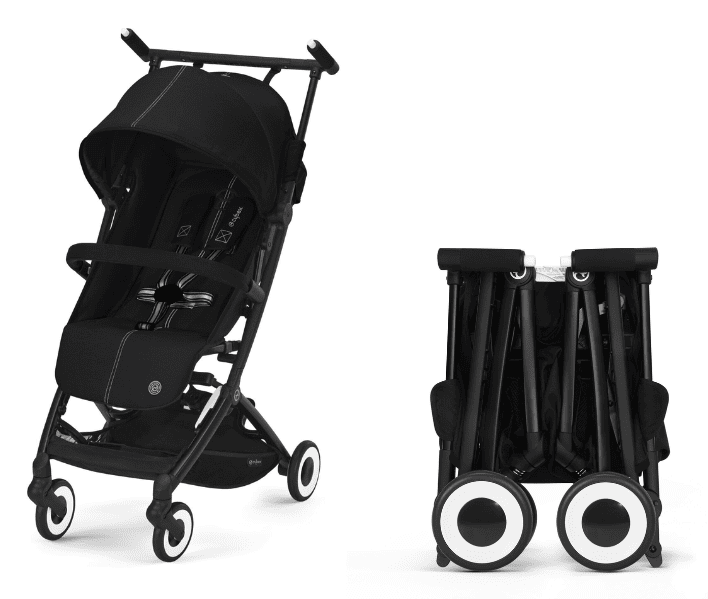
Material:
- Frame: Often made of aluminum or a similar lightweight yet sturdy material.
- Fabric: Typically made from durable, easy-to-clean materials such as polyester.
Weight and Dimensions:
- Weight: Generally, these pushchairs are lightweight, ranging from 13 to 20 pounds.
- Folded Dimensions: Designed to fold down to a compact size, making them easily portable and storable.
Seating:
- Seat Recline: Features adjustable seat recline positions to accommodate napping and upright seating.
- Harness: Equipped with a 5-point safety harness to secure the child safely.
Wheels and Suspension:
- Wheels: Usually equipped with swivel front wheels for maneuverability and lockable rear wheels for stability.
- Suspension: Some models incorporate suspension systems to ensure a smooth ride on various terrains.
Canopy:
- Adjustable Canopy: Includes a canopy to protect the child from sun exposure and mild rain, often adjustable to various positions.
Additional Features:
- Storage Basket: Equipped with a storage basket underneath the seat for storing essentials like diapers, wipes, and personal belongings.
- Cup Holder: Some models come with a cup holder to keep drinks within easy reach.
- Adjustable Handles:
Handle Height:
- Features handles with adjustable heights to suit caregivers of various heights.
Safety Features:
- Brakes: Equipped with easy-to-use brakes for safety and stability when stationary.
Tricycle with Push Handles – Stroller Alternatives
Push Tricycles:
Push tricycles are a type of three-wheeled vehicle designed for toddlers and young children, which combine the functionalities of a stroller and a tricycle.
They are equipped with a push handle operated by an adult to control the direction and speed of the tricycle, allowing the child to enjoy the ride safely.
As the child grows and gains more control and coordination, the push handle can often be removed to allow the child to pedal and steer independently.
These tricycles are aimed at promoting outdoor activity and aiding in the development of motor skills.
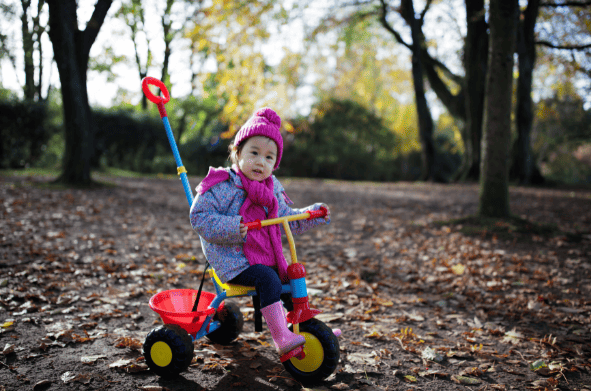
Material:
- Frame: Usually constructed from steel or aluminum for durability and stability.
- Seats and Handles: Often crafted from high-quality plastics or cushioned materials to ensure comfort and a firm grip.
Age and Weight Capacity:
- Age Range: Generally designed for children between the ages of 1 to 5 years.
- Weight Capacity: Usually capable of supporting a child weighing up to 55 pounds, but this can vary between models.
Wheels:
- Durable Wheels: Equipped with sturdy wheels that provide a smooth ride and are capable of traversing a variety of surfaces.
- Wheel Size: The size of the wheels can vary, but they are designed to offer stability and ease of control.
Adjustable Features:
- Push Handle: Features an adjustable push handle that can be adapted to the height of the parent or caregiver.
- Seat: Often comes with an adjustable seat to accommodate the child’s growth.
Safety Features:
- Safety Harness: Includes a safety harness (often a 3-point harness) to secure the child in the seat.
- Safety Bar: Some models feature a safety bar that encircles the child for added security.
Comfort Features:
- Sun Canopy: Certain models come with a sun canopy to protect the child from sun exposure.
- Footrest: Usually equipped with a footrest for younger children who cannot reach the pedals.
Additional Features:
Storage Basket: Equipped with a storage basket for holding baby essentials or toys.
Cup Holder: Some come with cup holders for holding drinks or snacks.
Convertible Design:
Convertible: Many push tricycles are convertible and can be adapted as the child grows, transitioning from a parent-controlled tricycle to a child-driven tricycle.
Saddle Baby Shoulder Carrier – Stroller Alternatives
Shoulder Carrier:
A shoulder carrier is a type of child carrier that allows a toddler or small child to sit on an adult’s shoulders safely.
These carriers typically consist of a seat that rests on the adult’s shoulders and a harness to secure the child.
It facilitates a higher vantage point for the child, making it an exciting option for outings, hikes, and sightseeing.
These carriers are designed for ease of use and to distribute the child’s weight evenly, preventing strain on the adult’s back and neck.
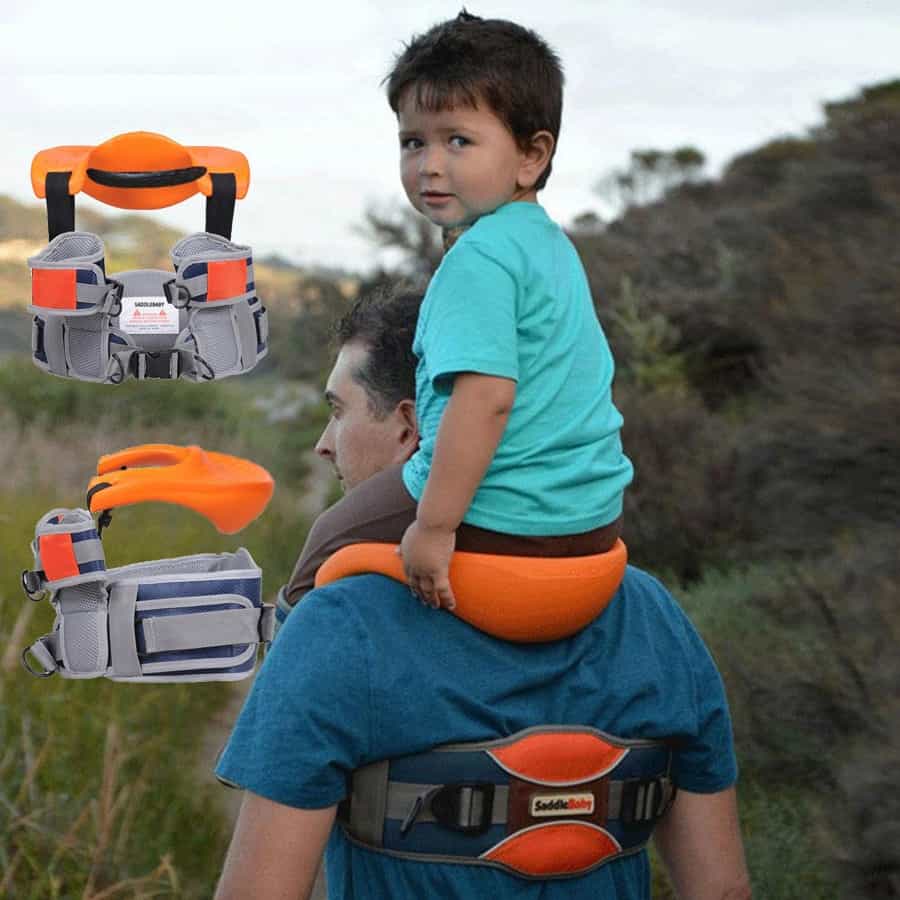
Material:
- Frame: Often constructed with sturdy materials such as aluminum or steel to provide support and durability.
- Fabric: Usually made from high-quality, breathable, and durable fabrics to ensure comfort and longevity.
Weight and Dimensions:
- Weight Capacity: Generally designed to carry children weighing between 15 to 50 pounds (6.8 to 22.7 kg).
- Carrier Weight: These carriers are lightweight, with most weighing between 2 to 7 pounds (0.9 to 3.2 kg).
Seat and Harness:
- Seat: Features a padded seat to provide comfort for the child.
- Harness: Equipped with a secure harness, usually a 5-point harness, to keep the child safely in place.
Adjustable Features:
- Shoulder Straps: Adjustable shoulder straps allow for comfortable positioning on the adult’s shoulders.
- Child Safety Straps: The harness straps are adjustable to secure the child properly.
Safety Features:
- Safety Locks: Some models feature safety locks to ensure that the harness does not come undone accidentally.
- Foot Straps: These are to secure the child’s feet, preventing dangling legs and promoting a more comfortable seating position.
Comfort Features:
- Padded Straps: Straps are often padded to prevent strain on the adult’s shoulders and neck.
- Headrest: Some carriers include a headrest for the child to lean on, enhancing comfort during longer outings.
Additional Features:
- Storage Pockets: Incorporates pockets to store small items such as keys, wallets, or snacks.
- Sun Canopy: Some carriers come with a removable sun canopy to protect the child from sun exposure.
Travel Systems – Stroller Alternatives
A 3-in-1 travel system is a versatile baby transportation solution that includes three essential components: a stroller, an infant car seat, and a car seat base.
This system is designed to provide a seamless transition for the baby from the car to the stroller and vice versa without disturbing the child. It offers convenience, safety, and comfort for both the baby and the parent, making travel, errands, and outings easier.
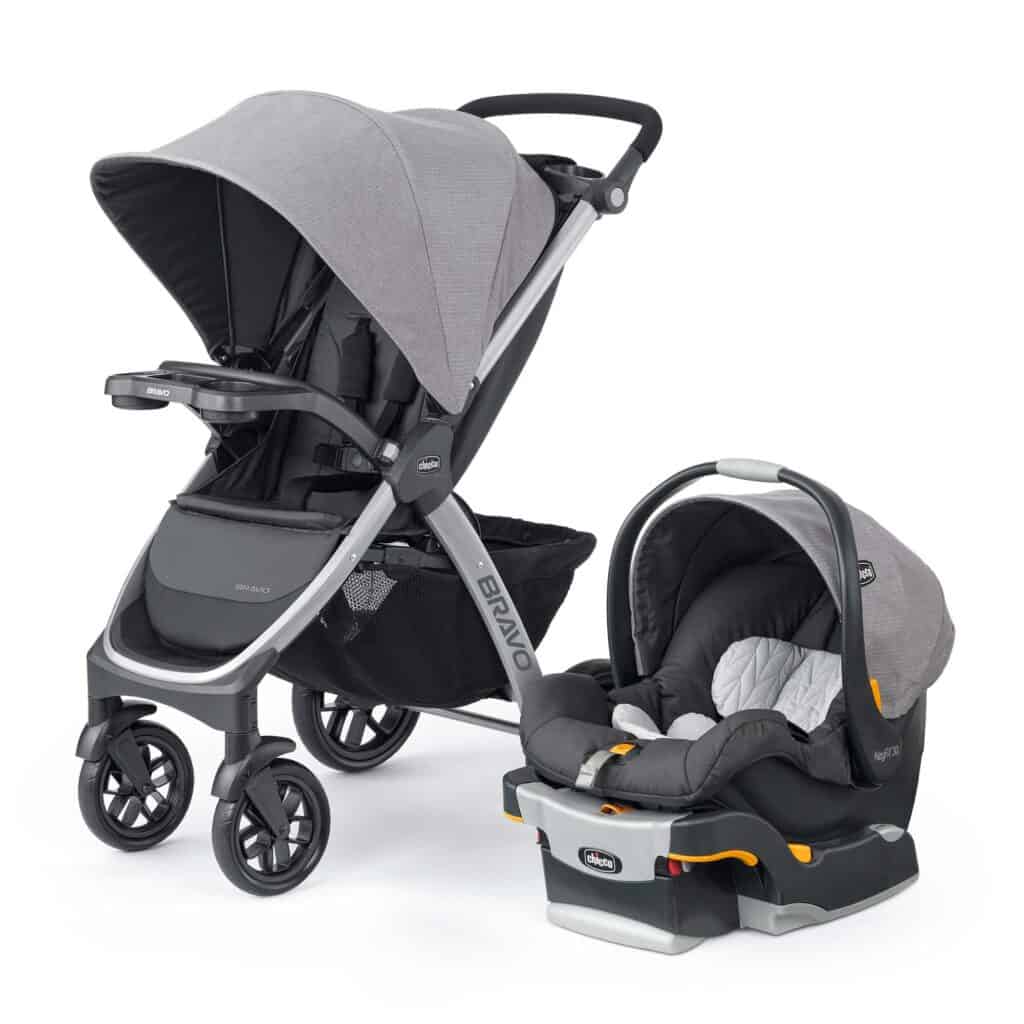
Components:
- Stroller: Usually features a robust frame with a comfortable seat that can recline in various positions.
- Infant Car Seat: A detachable car seat that can be secured in a car with the aid of a base and can also be attached to the stroller frame.
- Car Seat Base: The base is installed in the car, allowing for easy attachment and detachment of the car seat.
Material:
- Frame: Typically made from aluminum or steel to ensure durability and stability.
- Fabric: The fabric components are often made from high-quality, breathable, and easy-to-clean materials.
Weight and Dimensions:
- Weight Capacity: Generally designed to accommodate children from infancy up to 50 pounds (22.7 kg) or more, depending on the model.
- Product Weight: The combined weight of the system can vary, but it is generally designed to be manageable for an average adult to lift and transport.
Wheels and Suspension:
- Wheels: Equipped with durable wheels, often featuring front swivel wheels for easy maneuverability and lockable rear wheels for stability.
- Suspension: Integrated suspension systems in many models provide a smooth ride on various terrains.
Safety Features:
- Harness: Both the stroller and car seat feature secure harness systems, usually 5-point harnesses, to keep the child safely restrained.
- Brakes: The stroller features easy-to-use brakes to securely hold the stroller stationary when needed.
Comfort Features:
- Adjustable Seat: The stroller seat can be adjusted to various reclining positions for the comfort of the child.
- Canopy: Both the stroller and car seat usually feature adjustable canopies to protect the child from sun and wind.
Additional Features:
- Storage Basket: Many models feature generous storage baskets underneath the stroller seat for holding baby essentials and personal belongings.
- Parent Tray: Some systems come with a parent tray with cup holders and a compartment for personal items.
Convertible Design:
- Convertible: The stroller part can often be converted to accommodate older children, offering extended usability.
Bicycle Trailers – Stroller Alternatives
Bike Trailers:
Bicycle trailers are specially designed carriages that can be hitched to the rear of a bicycle, enabling parents or guardians to take children, pets, or cargo along on bike rides.
These trailers are generally designed with stability in mind to ensure the safety and comfort of the occupants or cargo. They often feature two wheels and a well-supported frame.
The trailers come in different varieties, including those designed for transporting children, pets, or cargo.
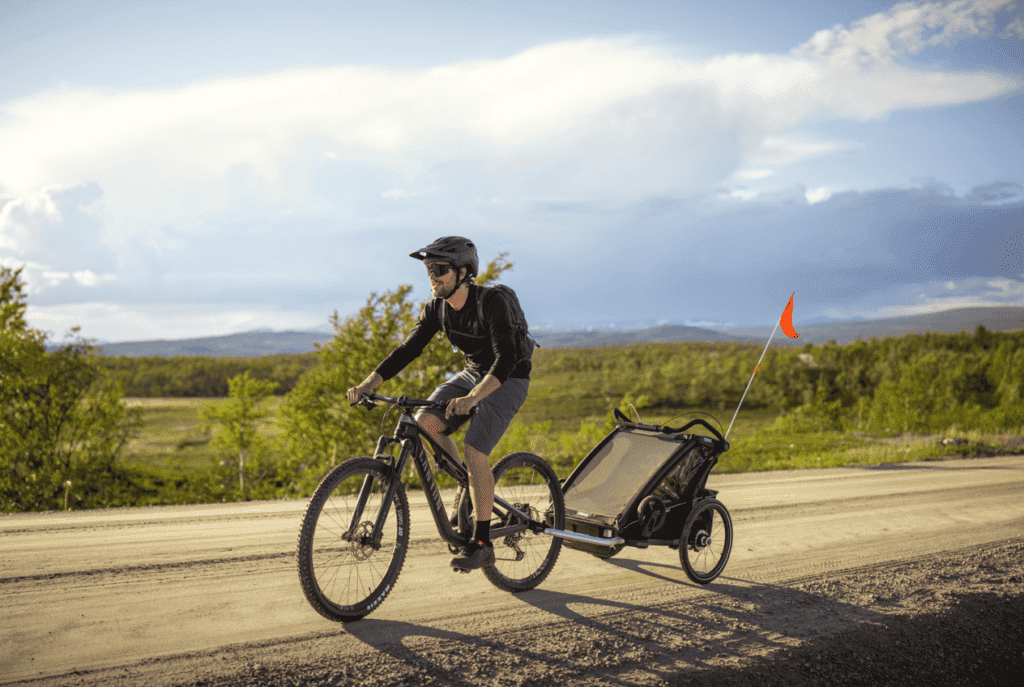
Material:
- Frame: Typically constructed from steel or aluminum for a balance of durability and light weight.
- Fabric: Often made from tough, weather-resistant materials like polyester or nylon to protect occupants from elements.
Wheels:
- Size: Generally equipped with large, sturdy wheels capable of handling various terrains.
- Material: Wheels are usually made of rubber with reinforced rims for durability.
Capacity:
- Weight Capacity: Depending on the design, they can carry anywhere from 50 to 100 pounds (22.7 to 45.4 kg) for child and pet carriers, and potentially more for cargo trailers.
- Occupancy: Child trailers often have options for one or two children.
Safety Features:
- Harness: Child trailers are equipped with safety harnesses, usually a 5-point harness system, to secure the child safely during the ride.
- Reflective Elements: Features reflective materials and flags for visibility on the road.
- Roll Cage: Often built with a roll cage to protect the occupant in case of a rollover.
Comfort Features:
- Suspension: Some trailers are equipped with suspension systems to offer a smoother ride.
- Windows: Features mesh windows for ventilation and clear plastic windows for protection against rain and wind.
Additional Features:
- Storage Space: Most trailers include additional storage space for carrying essentials like diapers, snacks, or pet supplies.
- Convertible: Some bicycle trailers can be converted into strollers, joggers, or even ski trailers, offering multi-seasonal, multi-sport use.
Attachment System:
- Hitch: Equipped with a hitching system to securely attach the trailer to the bicycle.
Toddler Walking Wings – Stroller Alternatives
Walking Wings:
Walking wings are designed to help toddlers learn to walk while reducing the risk of falls and stumbles. They are essentially a harness that a child wears, which has straps that parents can hold, allowing them to maintain an upright position without bending over. This not only helps in maintaining the child’s balance but also prevents strain on the parent’s back and shoulders.
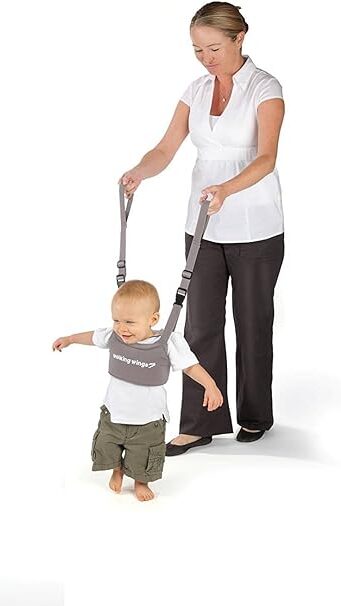
Material:
- Fabric: Generally made with soft, breathable yet durable fabric to prevent irritation on the child’s sensitive skin. Materials may include cotton and polyester blends.
Design:
- Harness: Features a harness that fits around the child’s chest and under the arms.
- Straps: Equipped with adjustable straps that parents can hold, often with padded handles for a comfortable grip.
Adjustable Features:
- Harness Size: The harness is usually adjustable to fit the growing child snugly and securely.
- Strap Length: The length of the straps can often be adjusted to suit the height of the parent or caregiver.
Safety Features:
- Secure Fastenings: Incorporates secure fastenings like buckles or Velcro to safely hold the child in place.
- Padded: The harness often has padded areas to ensure the comfort of the child.
Age and Weight Recommendations:
- Age Range: Suitable for toddlers who are learning to walk, generally between the ages of 6 to 18 months.
- Weight Capacity: Usually designed to accommodate toddlers within a weight range of 15 to 26 pounds (6.8 to 11.8 kg), although this can vary.
Luggage Ride-Ons – Stroller Alternatives
Ride-On Suitcases:
Ride-on suitcases are innovative luggage pieces designed for young children. These suitcases serve dual purposes: as a functional storage space for children’s belongings and as a ride-on toy that keeps children entertained during travel.
They usually feature a sturdy yet lightweight design, with wheels and a strap or handle that allows children to ride on them or parents to pull them along.
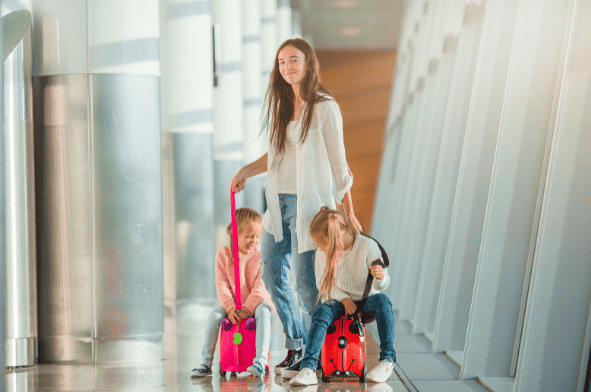
Material:
- Shell: Often constructed with hard yet lightweight materials such as plastic or polycarbonate to ensure durability and ease of handling.
- Interior: The interior is generally lined with fabric, and may feature compartments or straps to secure belongings.
Wheels:
- Number of Wheels: Usually equipped with four wheels for stability, allowing 360-degree maneuverability.
- Wheel Material: Wheels are often made of durable plastic or rubber.
Handles:
- Retractable Handle: Features a retractable handle that can be adjusted to suit the child’s height.
- Additional Handles: May also have additional handles for carrying by hand.
Capacity:
- Storage Space: The interior is designed to offer ample space for storing children’s clothing, toys, and other travel necessities.
- Weight Capacity: Generally, they can handle the weight of a child between the ages of 3 and 7, though it is advised to check specific product recommendations.
Safety Features:
- Secure Locks: Often come with secure locks or clasps to keep belongings safe.
- Stable Design: Designed to be stable to prevent tipping over when a child is riding on it.
Dimensions:
- Size: Compact enough to qualify as hand luggage on airplanes, but it is always best to check specific airline regulations.
Piggyback Rider – Stroller Alternatives
Piggyback Rider Carrier:
The Piggyback Rider carrier is a unique child carrier designed to carry toddlers and young children on the parent’s back, offering a piggyback ride experience.
It mainly consists of a bar attached to shoulder straps worn by the adult, and the child stands on the bar. It provides an elevated view and a fun riding experience for children while keeping the hands of the parents free. It is popular for hikes, walks, and other outings.

Material:
- Frame: Made from robust materials like aluminum or steel to ensure structural integrity and safety.
- Straps and Harness: Fabric components are generally made from durable, high-quality materials such as nylon or polyester.
Design:
- Bar for Standing: Features a bar where the child stands, offering a secure platform for them to enjoy the ride.
- Shoulder Straps: Equipped with shoulder straps that distribute the child’s weight evenly across the adult’s shoulders.
- Safety Harness: Includes a safety harness to secure the child safely and prevent falls.
Weight and Dimensions:
- Weight Capacity: Typically designed to carry children weighing up to 50 pounds (22.7 kg), though this may vary between models.
- Product Weight: Generally lightweight to facilitate ease of use and prevent strain on the adult.
Safety Features:
- Non-Slip Bar: The standing bar often features a non-slip surface to prevent the child from slipping.
- Safety Straps: Comes with safety straps that secure the child to the adult, offering additional security.
Comfort Features:
- Padded Straps: The shoulder straps are usually padded to ensure comfort for the adult.
- Ergonomic Design: Designed to provide a comfortable riding position for the child, promoting a natural stance.
Scooter Attachments – Stroller Alternatives
Scooter Attachments:
Scooter attachments are accessories or add-ons that can be affixed to a scooter to enhance its functionality or safety. These attachments can range from baskets for storage to seats for younger riders, and they are designed to customize the scooter to the specific needs or preferences of the user. They are popular for both children’s and adults’ scooters.

Types of Attachments:
- Storage Baskets: Usually made of metal or plastic, they attach to the handlebars or the deck of the scooter to provide space for storing personal belongings or groceries.
- Seats: These can be added to scooters to allow for seated riding. They are typically padded for comfort and may have adjustable heights.
- Lights and Reflectors: Designed to enhance visibility and safety during nighttime rides. They can be attached to various parts of the scooter.
- Handlebar Grips: These are added to the handlebars to provide a comfortable grip, often made from foam or rubber.
- Child Handle Attachments: These are additional handles that can be fixed to the scooter’s handlebars to allow younger riders to hold on securely.
Material:
- Durability: Made from durable materials like steel, aluminum, or heavy-duty plastic to withstand regular use and the elements.
Compatibility:
- Universal Attachments: Many attachments are universal and can fit a variety of scooter models, while others might be specific to certain brands or types.
Installation:
- Ease of Installation: Most attachments can be installed easily with simple tools or no tools at all.
Double Stroller Alternatives for Multiple Kids
Pull-Along Wagons
Folding Wagons:
Folding wagons are versatile, portable utility wagons that can be folded to a compact size for easy storage and transportation. They are widely used for various outdoor activities such as gardening, beach outings, and carrying groceries or kids. These wagons are designed to be durable and easy to use, making the transportation of goods simpler and more convenient.

Material:
- Frame: Often constructed from sturdy materials like steel or aluminum for a durable framework.
- Fabric: The carrying area is typically made from a heavy-duty fabric such as polyester or nylon, which is known for its durability and resistance to wear and tear.
Wheels:
- Type of Wheels: Most folding wagons have robust wheels that can maneuver different terrains. Some are equipped with wider wheels for stability on sandy or uneven grounds.
- Swivel Wheels: Front swivel wheels allow for easier steering and control.
Capacity:
- Weight Capacity: Folding wagons generally have a substantial weight capacity, often ranging from 150 to 300 pounds (68 to 136 kg).
- Volume Capacity: They offer a generous amount of space to carry various items, including cooler boxes, beach gear, or garden supplies.
Foldable Mechanism:
- Ease of Folding: They are designed to be folded and unfolded easily, often requiring only a few simple steps for both processes.
- Compact Size: When folded, they become compact, facilitating easy storage and transportation.
Handles:
- Adjustable Handle: Many models feature an adjustable handle to suit users of different heights and to help navigate various terrains easily.
Additional Features:
- Pockets and Holders: Some models come with built-in pockets, cup holders, or other compartments for organized storage and easy access to small items.
- Canopy: Certain folding wagons come with a removable canopy to protect the contents from sun or rain.
Board Attachments – Stroller Alternatives
Buggy Boards:
Buggy boards are attachments designed for strollers or pushchairs to provide a standing platform for older toddlers or young children.
It allows the child to ride along with a younger sibling who is seated in the stroller, offering a practical solution for families with children of different ages. It essentially converts a single stroller into a double, without the bulkiness of a tandem stroller.
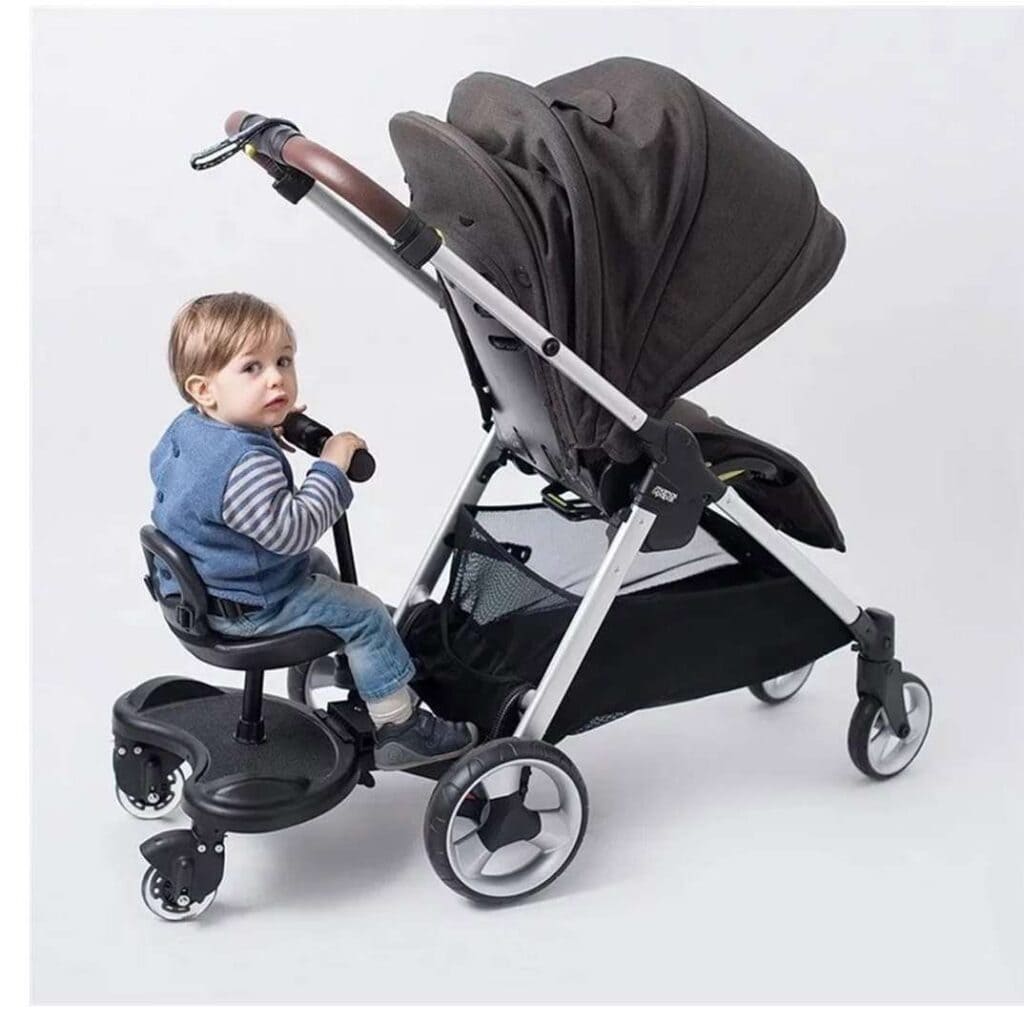
Material:
- Platform: Generally made from durable, high-quality plastics to withstand the weight of a child.
- Wheels: Often constructed with strong materials like rubber for a smooth and stable ride.
Design:
- Universal Connector: Designed with universal connectors that allow it to be attached to most types of strollers or pushchairs.
- Anti-Slip Surface: The platform usually features an anti-slip surface to prevent the child from slipping.
Weight and Dimensions:
- Weight Capacity: Typically, buggy boards can support children up to 44-50 pounds (20-23 kg), but this can vary between models.
- Size: The size is designed to not interfere with the stroller’s wheels and to give sufficient space for the child to stand comfortably.
Safety Features:
- Safety Strap: Often equipped with a safety strap that can secure the board to the stroller when not in use.
- Wheel Suspensions: Some boards feature wheel suspensions to provide a smoother ride.
Additional Features:
- Quick Release System: Many have a quick release system for easy attachment and detachment.
- Adjustable Width: Some buggy boards have an adjustable width to fit different stroller widths.
Frequently Asked Questions
How do you transport a baby without a stroller?
To transport a baby without a stroller, you can use various types of baby carriers like wraps, slings, and structured carriers, or utilize hip seats and portable bassinets. When choosing an option, prioritize ergonomic design, safety features, and weather protection.
What is an alternative to a stroller for older children?
For older children, alternatives to strollers include walking harnesses, wrist leashes, and ride-on boards for controlled mobility. Backpack carriers and piggyback rider carriers offer comfortable carrying options. Bicycle trailers, scooter attachments, and folding wagons provide transport during outdoor activities, while 3-in-1 travel systems and ride-on suitcases offer versatile solutions.
How do you travel with a toddler without a stroller?
Traveling with a toddler without a stroller can be facilitated using alternative gear like toddler carriers, backpack carriers, harnesses, folding wagons, ride-on suitcases, and piggyback rider carriers.
At what age should you stop using a stroller?
The appropriate age to stop using a stroller can vary depending on various factors including the child’s physical development, the context of the use, and individual preferences. Generally, children transition out of strollers between the ages of 3 and 5 years old.
Conclusion
They say it takes a village. Where can I get directions to this village?
In conclusion, going out with toddlers can be easy and hassle-free thanks to the many stroller alternatives available today.
Harnesses and leashes can offer a safe yet independent walking experience for the little explorers, while bicycle trailers bring in an element of adventure to your outings. For older children, buggy boards present an exciting ride-along experience.
Moreover, innovations like luggage ride-ons and portable folding wagons have not only made traveling with toddlers more manageable but also more fun and engaging.
Choosing the right stroller alternative depends on various factors including the nature of your trip, your child’s comfort, and the level of safety provided by the product.
Therefore, it is crucial to analyze different options and choose one that aligns well with your family’s travel style.
Happy traveling!
Our Most Popular Blogs
- 100 Bengali Girl Names – Rare And Unique Names for Your Little One
- https://findmyfit.baby/bengali-girl-names/
- Types Of Stroller Wheels: Rolling In Style Guide
- https://findmyfit.baby/a-guide-to-the-different-types-of-stroller-wheels/
- 61 Expert Tips on How to Choose a Stroller: We Answer All Your Questions!
- Best Travel Strollers for Airplane – Complete Guide
References
Reddit – Recommendation for stroller alternative
Indemnity
This information is provided for educational and entertainment purposes only.
We, Find My Fit (www.findmyfitbaby.com) do not accept any responsibility for any liability, loss, or risk, personal or otherwise, incurred as a consequence, directly or indirectly, from any information or advice contained here. We may earn compensation from affiliate links in this content
Follow us on Pinterest:
https://za.pinterest.com/findmyfitbaby/
